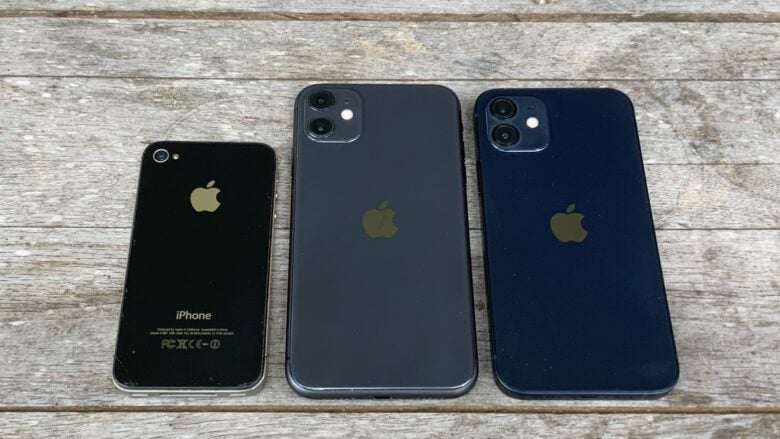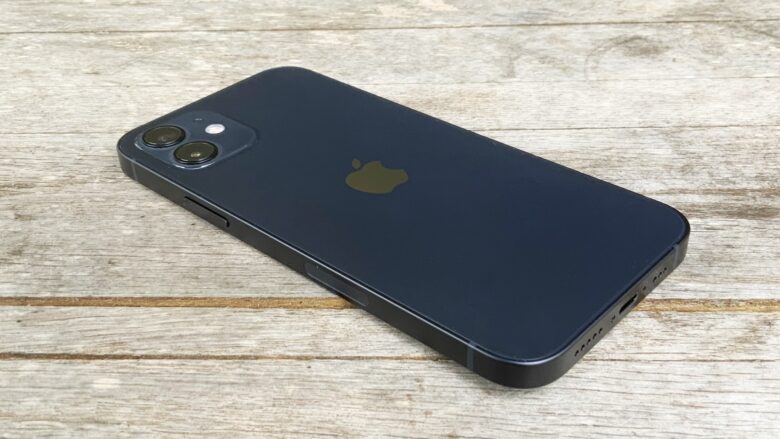There’s no need to struggle to decide which of the four iPhone 12 versions is the best. The 6.1-inch “standard” version packs all the features most people need — like 5G and a great camera — while coming in at a price far lower than the Pro series.
After plenty of real-world use, here are all the reasons why the iPhone 12 (non-Pro, non-mini) is the right choice.
iPhone 12 review
Millions of people held off, waiting for an iPhone with high-speed 5G cellular. The next-gen networking finally arrived with the iPhone 12, but there’s a quartet of versions to choose from. Screen sizes range from 5.4 inches (the iPhone 12 mini) to 6.7 inches (iPhone 12 Pro Max). Base prices go from $699 all the way to $1,099.
I’m here to make your iPhone 12 decision easier. Save your money and your eyesight. The 6.1-inch, $799 version is the best all-around choice for most people. The pricier Pro models don’t offer enough additional benefits to justify the considerable extra cost.
Design
The iPhone 12 looks like the iPhone 4 and the iPhone 11 hooked up and had a baby. Apple’s latest design offers many of the same features as its immediate predecessor, but with the flat edges of the 2010 model.
The resulting 6.1-inch version of this new handset is slightly thinner and shorter than the 2019 model with the same screen size. By flattening the edges, Apple got rid of some of the dead space around the screen. And the iPhone 12 is definitely more comfortable in the hand. Those flat edges are more secure to hold, too.
But that’s true for all the newest iOS handsets. The difference in the series is about size. The iPhone 12 Pro Max is more than half an inch taller than the standard iPhone 12. And it’s a quarter inch wider. That’s a lot of extra bulk to carry around.
There is an internal difference, too. The standard version uses an aluminum frame while the Pro has a stainless steel one. But it’s not clear if this makes the more-expensive devices any more rugged. The standard iPhone 12 certainly isn’t easy to bend.

Photo: Ed Hardy/Cult of Mac
Display
The 6.1-inch screen really helps make the iPhone 12 the version to go with. Look at the specs: The display offers a 2,532‑by‑1,170-pixel resolution, giving it 460 pixels per inch. That’s a far higher resolution than the the iPhone 11 it’s replacing — that model has a screen with a 1,792‑by‑828‑pixel resolution at 326 ppi.
But the advantage goes beyond specs. Honestly, the 6.1-inch screen on the iPhone 12 is beautiful. Just right for images, games, social networking. Really, everything you carry a phone for. And at 625 nits, it’s plenty bright enough to be usable outdoors.
Now consider the other options in the series. The iPhone 12 Pro Max has that massive 6.7-inch screen. It’s like a small tablet. But if what you want is a small tablet, get an iPad mini. It’ll have an even larger display and you won‘t have to tote it everywhere you take your phone.
And while the 5.4-inch iPhone mini undoubtedly has fans (it won the heart of my colleague Luke Dormehl), it’s got to feel a bit cramped for even moderate use.
The 6.1-inch model is the “Goldilocks” version. Not too big. Not too small. Just right.
Camera
The iPhone 12 includes a dual-camera setup, boasting 12-megapixel ƒ/1.6-aperture wide camera and and ultrawide ƒ/2.4-aperture camera. But those are just numbers. What do they mean for real-world use?
These days, a decent phone from any company can take great pictures in good light. Apple works hard to let iPhone take beautiful pictures under less ideal conditions.

Photo: Ed Hardy/Cult of Mac
First off, there’s Deep Fusion, which improves images captured in medium lighting. Rather than taking a single image when you press the shutter button, the iPhone 12 camera captures both short-exposure and long-exposure images. It then intelligently merges them to produce the best-looking picture possible, on a pixel-by-pixel basis. This happens with every camera, even the front-facing one.
Second, the iPhone 12 offers Night mode. This is a simplified system for taking long-exposure photographs in very low-light situations. This is a cool effect, it’s not always practical because it requires the subject of the photo to stay still. I’ve managed a cool Night mode picture or two of my cat, but most of them are blurred because he moves while the image is being captured.
And that leads to an important point. The more expensive iPhone 12 Pro has some additional tricks. And that’s even more true for the iPhone 12 Pro Max. But, realistically, these are only going to be used by professionals and serious camera hobbyists. Nobody but Steven Spielberg will (or should) record their grandchild’s birthday party in HDR video with Dolby Vision at 60 fps.

Photo: Ed Hardy/Cult of Mac
So think about it: Even the standard 6.1-inch iPhone offers more camera features than most people will use. And, unless you’re a budding filmmaker, the Pro series is complete overkill.
The more expensive iPhone 12 models also come with built-in LiDAR Scanners, which might be a big thing someday. For right now, this laser scanner is primarily used to speed up focusing in low-light images. But the tech also has the potential to make augmented reality applications much better. Right now, though, it’s nearly useless for this because the breakthrough apps aren’t here yet. This feature has been on the 2020 iPad Pro for half a year, and I forget about it for months at a time.
iPhone 12 performance
All four of the iPhone 12 series models come with the Apple A14 Bionic processor at their heart. All of them. So don’t expect the Pro, which costs 25% more than the standard version, to deliver better performance. It does not.
According to official results from Primate Labs, the Geekbench 5 multi-core score for the standard iPhone 12 is 3891. The 12 Pro pulls in a slightly slower 3822. Yes, slower. My own tests of the iPhone 12 pulled in a multi-core score of 3964.
In short, don’t pay more for an iPhone 12 Pro expecting faster performance because you’ll be disappointed.
Apple did give the Pro models more RAM. The standard iPhone 12 comes with 4GB, while the more expensive devices pack 6GB. This is a nice benefit, but 4GB is sufficient for most people. iOS does an expert job of managing RAM (unlike Android), so a huge amount seems unnecessary.
The Pro models also offer more storage. The standard model starts at 64 GB, while the Pro starts 128 GB. But the iPhone 12 can be upgraded to 128 GB for $50. There’s no need to get the Pro just to have more storage.
And if all you’re looking for is iOS 14, every iPhone released for many years can upgrade to the latest version of Apple’s mobile operating system. There’s absolutely no reason to get a pricier model just for this.
5G
The signature feature of the iPhone 12 series is 5G cellular-wireless networking. It offers faster data connection speeds than 4G LTE. Or even Wi-Fi. My own tests confirm this. In spot checks around Atlanta, the latest iPhone saw 5G connections as high as 179 Mbps. Multiple tests came in at over 100 Mbps.
Trouble is, the telecoms are still building out their 5G networks. I saw the fastest connections downtown, especially near Georgia Tech. In my yard out in the suburbs, speeds fell to around 30 Mbps. But this is a location where 4G coverage isn’t good — LTE speeds are generally a bit under 30 Mbps.
That’s not a condemnation. 5G is still going through the same process as 4G and 3G before it. It takes a while for solid coverage to be widespread, even around big cities. But if you’re planning to use your iPhone for three or four years, you don’t want to buy a new model now that doesn’t have 5G — you’ll greatly regret it in 2024.
But every iPhone 12 model comes with the same 5G capabilities. Putting down extra cash for a Pro won’t get you a better wireless networking experience.

Photo: Ed Hardy/Cult of Mac
Charging and MagSafe
Apple didn’t do us the favor of switching to USB-C for the iPhone 12 lineup. Instead, we’re still stuck with a Lightning port for wired charging and data transfers.
But the iPhone 12 does bring MagSafe wireless charging, a noticeable improvement over basic Qi. With a compatible charger — there aren’t many yet — the handset can receive power at 15W, twice as fast as previous Apple models.
And MagSafe includes magnets so the iPhone and charger automatically align themselves properly for current to transmit. An unfortunate side effect is that the Apple MagSafe Charger clings to the handset just a bit more than is convenient. You can’t disconnect it simply by picking up the iPhone.
Again, this enhanced wireless feature is identical in all iPhone 12 models. It doesn’t get better by paying more.
The 6.1-inch standard and Pro versions have the exact same battery. And with identical processors and nearly identical displays, these two are inevitably going to last the same length of time between charges.
In my real-world tests, the standard iPhone 12 was able to get me though a day of average use. At no point did I say, “The battery is dead already?!” The experience was the same as my year with the iPhone 11.
We don’t know yet how battery life for the iPhone 12 Pro Max will stack up, as the biggest model does not arrive until November.
Pricing
Most Americans will put down $799 for the standard iPhone 12. That’s $100 more than the equivalent iPhone 11, but Apple added some upgrades like 5G and a speedier processor. And don’t forget that the screen is noticeably improved.
Going to an iPhone 12 Pro adds an additional $200 to the bill. As discussed, primarily what you get for that is a fancier camera, more RAM and additional storage. Moving to the 12 Pro Max brings a larger display and even better cameras, but it costs $300 more than the standard version.
But there’s no difference in processor or 5G or MagSafe for any of the iPhone 12 models, despite all the extra cost. And don’t forget that you can add more storage to the standard model for considerably less than jumping up to a Pro. Upgrading to 128GB of storage capacity costs just $50.
iPhone 12 review: Final thoughts
For most users, the Pro models simply don’t deliver enough of an improvement to justify the additional cost. This is because so many of the features of all four devices are the same, including processor performance and 5G.
The primary variation in the four iPhone 12 models is screen size. As discussed above, the options range from 5.4 inches to 6.7 inches. But the standard 6.1-inch version is the sweet spot.
True, the two Pro models have better cameras. But even the standard iPhone 12 offers more features than typical users will probably take advantage of. If you’re looking for a point-and-shoot experience, there’s no need to go with the Pro.
And the price difference isn’t small. You’ll pay either 25% or 37.5% more for a Pro than the standard model. Some people think that a more-expensive device is automatically better. To them, the iPhone 12 Pro Max is the most expensive version, so it must be the best. Not in this case. It’s just the biggest. The standard iPhone 12 is really the best.
Apple did not provide Cult of Mac with a review unit for this article. See our reviews policy, and check out more in-depth reviews of Apple-related items.
![IPhone 12 is so good, there’s no real reason to go Pro [Review] iPhone 12 review](https://www.cultofmac.com/wp-content/uploads/2020/10/9A869CFF-75FF-467C-9CB7-35FD5745ABAF-1536x864.jpeg)

